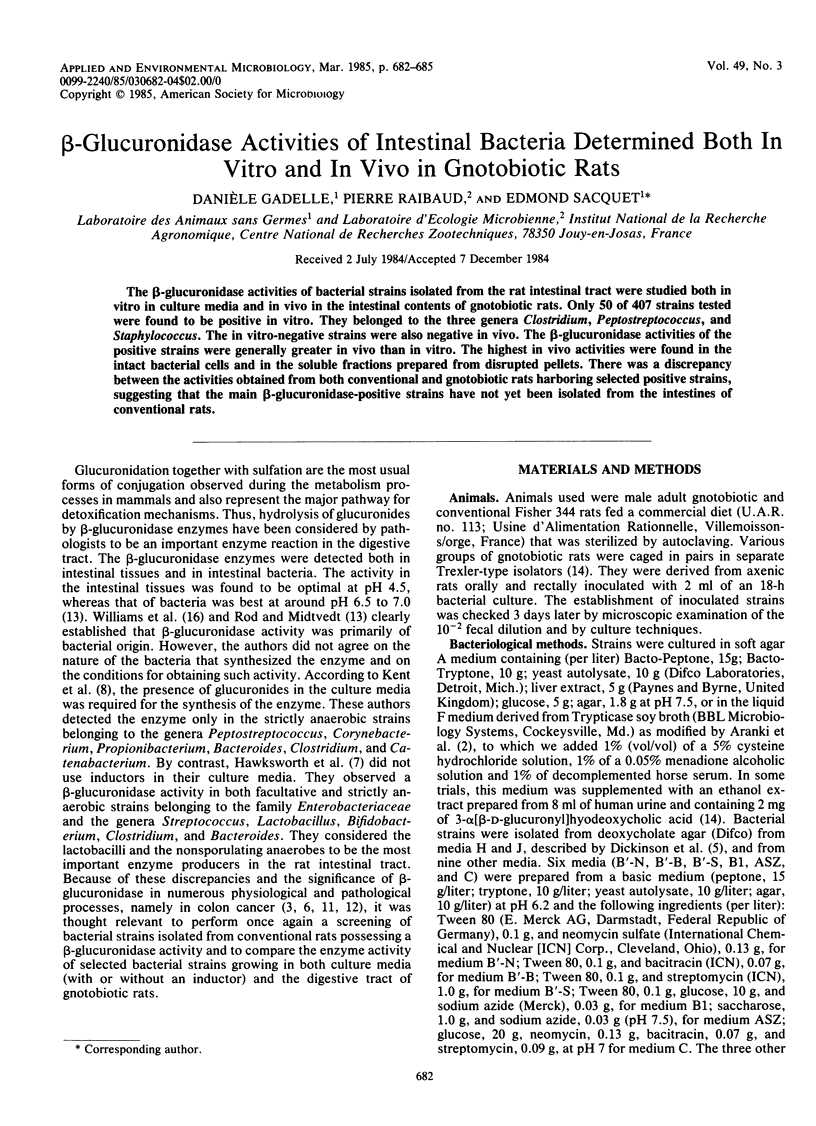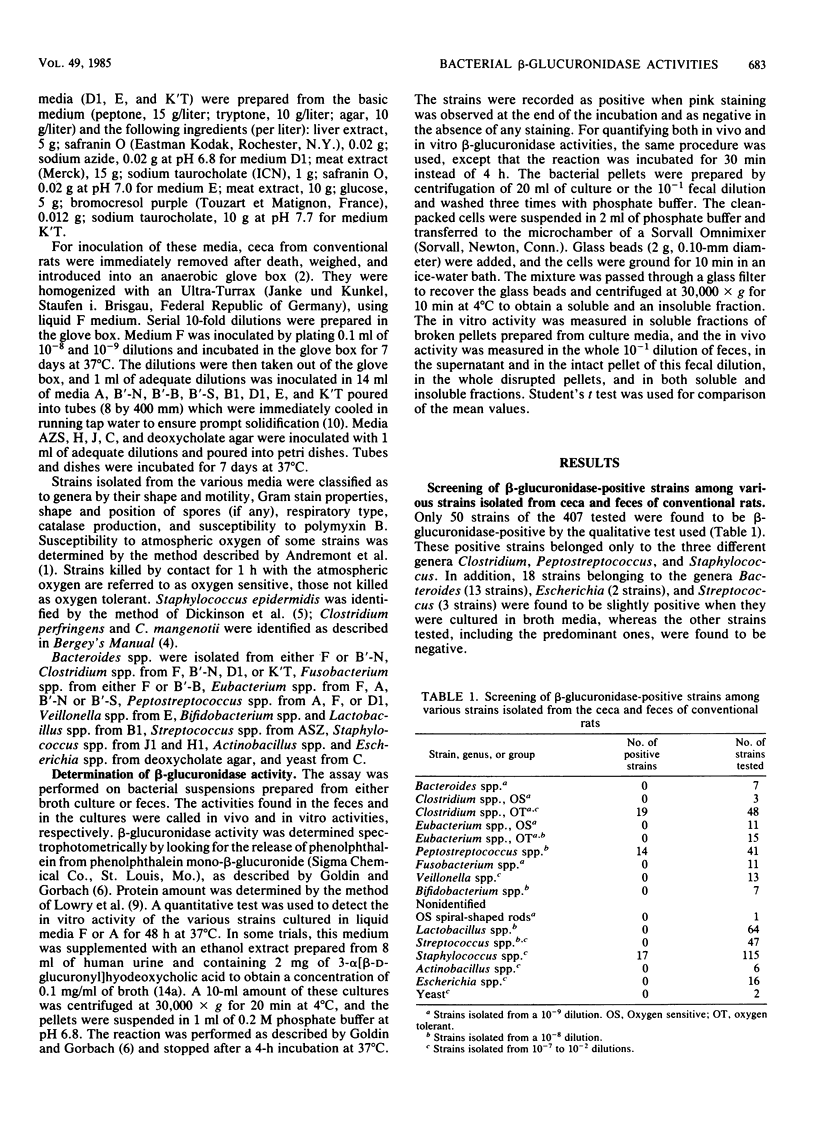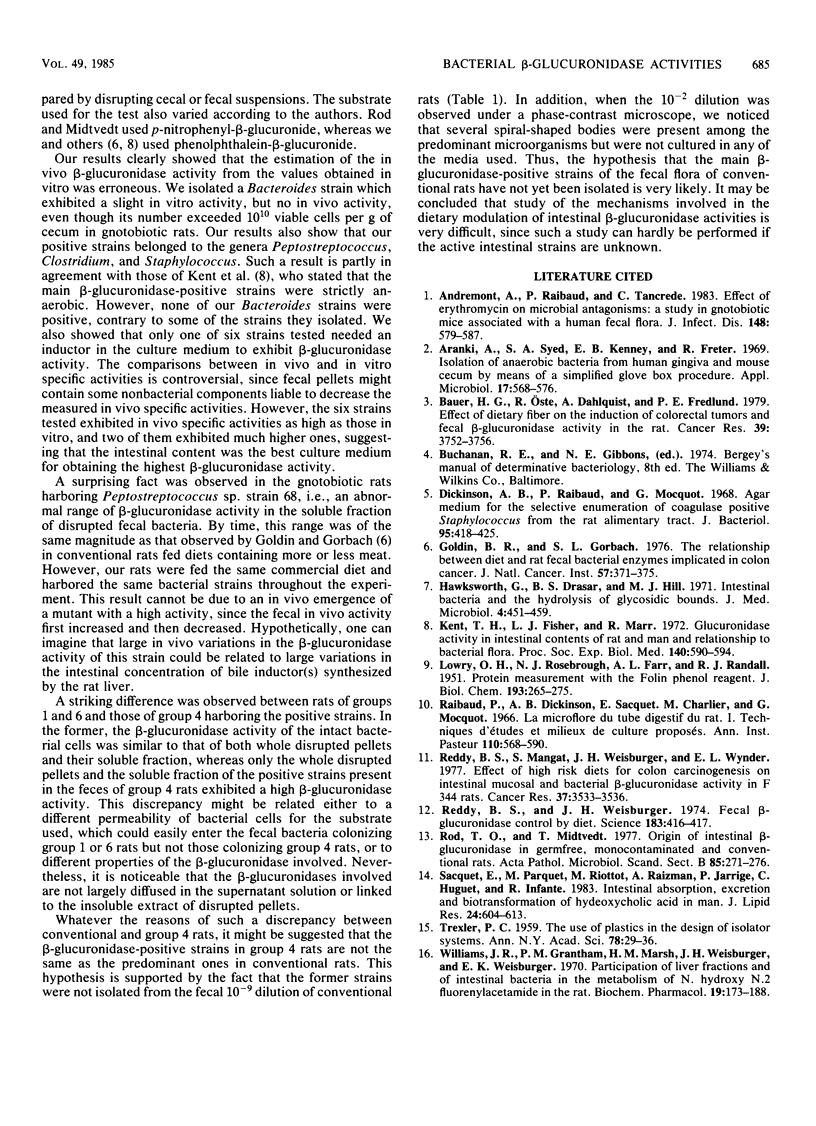Abstract
The beta-glucuronidase activities of bacterial strains isolated from the rat intestinal tract were studied both in vitro in culture media and in vivo in the intestinal contents of gnotobiotic rats. Only 50 of 407 strains tested were found to be positive in vitro. They belonged to the three genera Clostridium, Peptostreptococcus, and Staphylococcus. The in vitro-negative strains were also negative in vivo. The beta-glucuronidase activities of the beta-glucuronidase activities of the positive strains were generally greater in vivo than in vitro. The highest in vivo activities were found in the intact bacterial cells and in the soluble fractions prepared from disrupted pellets. There was a discrepancy between the activities obtained from both conventional and gnotobiotic rats harboring selected positive strains, suggesting that the main beta-glucuronidase-positive strains have not yet been isolated from the intestines of conventional rats.
Full text
PDF



Selected References
These references are in PubMed. This may not be the complete list of references from this article.
- Andremont A., Raibaud P., Tancrède C. Effect of erythromycin on microbial antagonisms: a study in gnotobiotic mice associated with a human fecal flora. J Infect Dis. 1983 Sep;148(3):579–587. doi: 10.1093/infdis/148.3.579. [DOI] [PubMed] [Google Scholar]
- Arank A., Syed S. A., Kenney E. B., Freter R. Isolation of anaerobic bacteria from human gingiva and mouse cecum by means of a simplified glove box procedure. Appl Microbiol. 1969 Apr;17(4):568–576. doi: 10.1128/am.17.4.568-576.1969. [DOI] [PMC free article] [PubMed] [Google Scholar]
- Bauer H. G., Asp N. G., Oste R., Dahlqvist A., Fredlund P. E. Effect of dietary fiber on the induction of colorectal tumors and fecal beta-glucuronidase activity in the rat. Cancer Res. 1979 Sep;39(9):3752–3756. [PubMed] [Google Scholar]
- Dickinson A. B., Raibaud P., Mocquot G. Agar medium for the selective enumeration of coagulase-positive Staphylococcus from the rat alimentary tract. J Bacteriol. 1968 Feb;95(2):418–425. doi: 10.1128/jb.95.2.418-425.1968. [DOI] [PMC free article] [PubMed] [Google Scholar]
- Goldin B. R., Gorbach S. L. The relationship between diet and rat fecal bacterial enzymes implicated in colon cancer. J Natl Cancer Inst. 1976 Aug;57(2):371–375. doi: 10.1093/jnci/57.2.371. [DOI] [PubMed] [Google Scholar]
- Hawksworth G., Drasar B. S., Hill M. J. Intestinal bacteria and the hydrolysis of glycosidic bonds. J Med Microbiol. 1971 Nov;4(4):451–459. doi: 10.1099/00222615-4-4-451. [DOI] [PubMed] [Google Scholar]
- Kent T. H., Fischer L. J., Marr R. Glucuronidase activity in intestinal contents of rat and man and relationship to bacterial flora. Proc Soc Exp Biol Med. 1972 Jun;140(2):590–594. doi: 10.3181/00379727-140-36510. [DOI] [PubMed] [Google Scholar]
- LOWRY O. H., ROSEBROUGH N. J., FARR A. L., RANDALL R. J. Protein measurement with the Folin phenol reagent. J Biol Chem. 1951 Nov;193(1):265–275. [PubMed] [Google Scholar]
- Raibaud P., Dickinson A. B., Sacquet E., Charlier H., Mocquot G. La microflore du tube digestif du rat. I. Techniques d'étude et milieux de culture proposés. Ann Inst Pasteur (Paris) 1966 Apr;110(4):568–590. [PubMed] [Google Scholar]
- Reddy B. S., Mangat S., Weisburger J. H., Wynder E. L. Effect of high-risk diets for colon carcinogenesis on intestinal mucosal and bacterial beta-glucuronidase activity in F344 rats. Cancer Res. 1977 Oct;37(10):3533–3536. [PubMed] [Google Scholar]
- Reddy B. S., Weisburger J. H., Wynder E. L. Fecal bacterial beta-glucuronidase: control by diet. Science. 1974 Feb 1;183(4123):416–417. doi: 10.1126/science.183.4123.416. [DOI] [PubMed] [Google Scholar]
- Rod T. O., Midtvedt T. Origin of intestinal beta-glucuronidase in germfree, monocontaminated and conventional rats. Acta Pathol Microbiol Scand B. 1977 Aug;85(4):271–276. doi: 10.1111/j.1699-0463.1977.tb01973.x. [DOI] [PubMed] [Google Scholar]
- Sacquet E., Parquet M., Riottot M., Raizman A., Jarrige P., Huguet C., Infante R. Intestinal absorption, excretion, and biotransformation of hyodeoxycholic acid in man. J Lipid Res. 1983 May;24(5):604–613. [PubMed] [Google Scholar]
- TREXLER P. C. The use of plastics in the design of isolator systems. Ann N Y Acad Sci. 1959 May 8;78:29–36. doi: 10.1111/j.1749-6632.1959.tb53093.x. [DOI] [PubMed] [Google Scholar]
- Williams J. R., Jr, Grantham P. H., Marsh H. H., 3rd, Weisburger J. H., Weisburger E. K. Participation of liver fractions and of intestinal bacteria in the metabolism of N-hydroxy-N-2-fluorenylacetamide in the rat. Biochem Pharmacol. 1970 Jan;19(1):173–188. doi: 10.1016/0006-2952(70)90338-2. [DOI] [PubMed] [Google Scholar]


